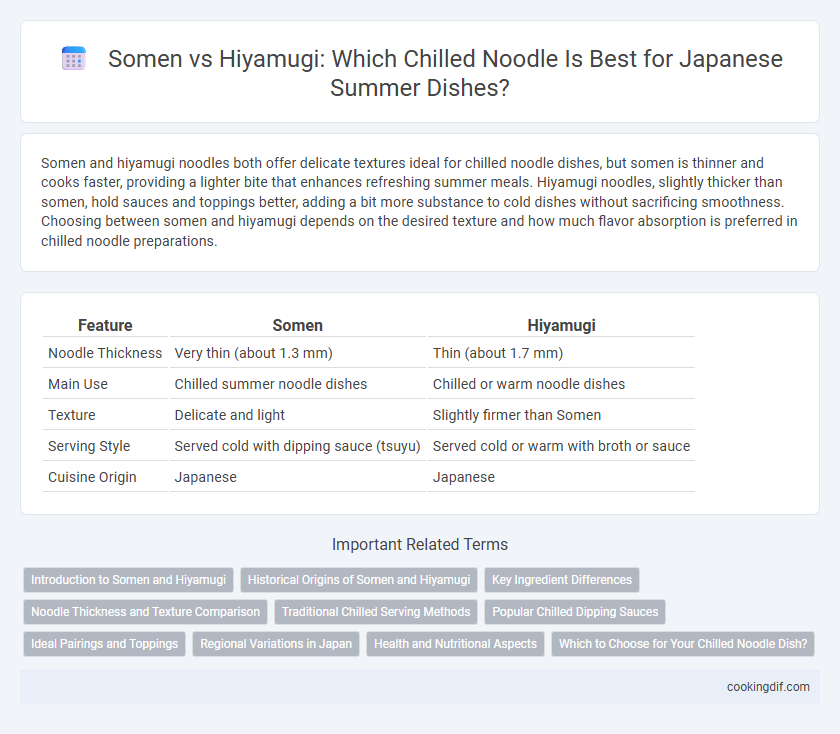Somen and hiyamugi noodles both offer delicate textures ideal for chilled noodle dishes, but somen is thinner and cooks faster, providing a lighter bite that enhances refreshing summer meals. Hiyamugi noodles, slightly thicker than somen, hold sauces and toppings better, adding a bit more substance to cold dishes without sacrificing smoothness. Choosing between somen and hiyamugi depends on the desired texture and how much flavor absorption is preferred in chilled noodle preparations.
Table of Comparison
| Feature | Somen | Hiyamugi |
|---|---|---|
| Noodle Thickness | Very thin (about 1.3 mm) | Thin (about 1.7 mm) |
| Main Use | Chilled summer noodle dishes | Chilled or warm noodle dishes |
| Texture | Delicate and light | Slightly firmer than Somen |
| Serving Style | Served cold with dipping sauce (tsuyu) | Served cold or warm with broth or sauce |
| Cuisine Origin | Japanese | Japanese |
Introduction to Somen and Hiyamugi
Somen are thin, white Japanese wheat noodles known for their delicate texture and quick-cooking properties, making them ideal for chilled noodle dishes during hot weather. Hiyamugi noodles, slightly thicker than somen but thinner than udon, offer a chewy texture that balances well with light, refreshing broths or dipping sauces. Both noodles are traditionally served cold with dipping sauces like tsuyu, but somen's slender form lends itself to a smoother mouthfeel compared to the heartier bite of hiyamugi.
Historical Origins of Somen and Hiyamugi
Somen noodles trace their origins to the Heian period in Japan, around the 9th century, where they were initially enjoyed by the aristocracy as thin, refined wheat noodles served chilled during summer. Hiyamugi emerged later as a slightly thicker counterpart, gaining popularity among commoners during the Edo period due to its economic production and refreshing qualities. Both noodles share wheat bases but distinct historical trajectories influencing their traditional use in chilled noodle dishes today.
Key Ingredient Differences
Somen noodles are ultra-thin, made primarily from wheat flour and water, resulting in a delicate texture ideal for light, chilled dishes. Hiyamugi noodles are thicker than somen but thinner than udon, incorporating wheat flour with a slightly higher gluten content, which gives them a sturdier bite perfect for cold soups and dipping sauces. The key ingredient difference lies in the texture and gluten composition, influencing their mouthfeel and suitability for specific chilled noodle dishes.
Noodle Thickness and Texture Comparison
Somen noodles are the thinnest Japanese wheat noodles, typically around 1.3 mm in diameter, offering a delicate, silky texture perfect for light chilled dishes. Hiyamugi noodles are slightly thicker, approximately 1.5 to 1.7 mm, providing a chewier bite that holds up well in cold broths while maintaining a smooth consistency. The difference in thickness affects the mouthfeel, with somen delivering a finer, more fragile texture and hiyamugi offering a heartier, more substantial noodle experience in chilled preparations.
Traditional Chilled Serving Methods
Somen and hiyamugi noodles both offer refreshing options for chilled noodle dishes, with somen being thinner and traditionally served chilled with a light dipping sauce known as tsuyu, often garnished with green onions and grated ginger. Hiyamugi, slightly thicker than somen but thinner than udon, is also served cold, typically chilled in ice water to maintain its firm texture, then paired with savory dipping sauces or cold broth. Traditional serving methods emphasize simplicity and subtle flavors, highlighting the delicate texture and clean taste of these wheat-based noodles.
Popular Chilled Dipping Sauces
Somen and Hiyamugi are thin Japanese noodles commonly served chilled, each offering a slightly different texture that complements various dipping sauces. Popular chilled dipping sauces for both include mentsuyu, a savory soy-based broth with dashi and mirin, enhancing the noodles' subtle flavors. Other favorites are sesame-based sauces and ponzu, a citrusy soy sauce blend that adds refreshing acidity ideal for warm summer months.
Ideal Pairings and Toppings
Somen noodles, thin and delicate, pair ideally with light, refreshing toppings such as grated ginger, thinly sliced scallions, and shredded nori, enhancing their subtle flavor in chilled dishes. Hiyamugi, slightly thicker than somen, complements heartier toppings like julienned cucumber, sesame seeds, and chilled tofu, providing a satisfying texture that holds up well to stronger sauces or dipping broths. Both noodles excel when served cold, but somen's fine texture suits minimalist, delicate pairings while hiyamugi thrives with more robust, textured ingredients.
Regional Variations in Japan
Somen and Hiyamugi are thin Japanese wheat noodles often enjoyed chilled, but regional preferences in Japan distinguish their use. Somen, thinner and more delicate, is favored in Kansai, especially during summer festivals in Osaka and Kyoto, while Hiyamugi, slightly thicker, is preferred in the Kanto region, including Tokyo, for its firmer texture in cold noodle dishes. These regional variations reflect local tastes and climate, influencing the choice of noodles for refreshing seasonal meals.
Health and Nutritional Aspects
Somen and Hiyamugi noodles both offer low-calorie, hydrating options ideal for chilled dishes, but somen typically contains slightly fewer calories and carbohydrates due to its finer strands, making it a preferred choice for those seeking lighter meals. Both noodles are made primarily from wheat flour, providing similar protein content, but somen's delicate texture facilitates quicker digestion, potentially benefiting individuals with sensitive digestive systems. The minimal fat content and inclusion of essential B vitamins in both somen and hiyamugi support energy metabolism, while their low glycemic index helps maintain stable blood sugar levels during hot weather.
Which to Choose for Your Chilled Noodle Dish?
Somen and Hiyamugi are popular Japanese chilled noodles, with somen being thinner and more delicate, perfect for light, refreshing dishes. Hiyamugi offers a slightly thicker texture, providing a chewier bite that pairs well with robust dipping sauces or toppings. Choose somen for a subtle, smooth experience, while hiyamugi suits those seeking a heartier, more textured chilled noodle dish.
Somen vs Hiyamugi for chilled noodle dishes Infographic

 cookingdif.com
cookingdif.com